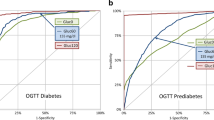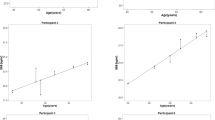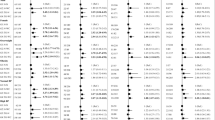Abstract
AIMS: The association between obesity and type 2 diabetes has been found to be consistent across different ethnic populations. Our aim was to study the contribution of obesity to the development of type 2 diabetes in a non-obese Chinese population with a high prevalence of diabetes (9.8% in 1995–1996).
METHODS: Six-hundred and forty-four non-diabetic subjects were recruited from the Hong Kong Cardiovascular Risk Factor Prevalence Study (1995–1996). This was a community-based population study which involved the use of a 75 g oral glucose tolerance test and 1985 World Health Organization diagnostic criteria. Their glycemic status was reassessed at 2 y.
RESULTS: In subjects with impaired glucose tolerance (n=322), the annual progression rate to diabetes (4.8%; 95% CI 2.5–7.1%), was 8-fold that in control subjects (0.6%; 95% CI 0.0–1.4%; P<0.001). Baseline waist–hip ratio (WHR; OR per unit increase=1.05; 95% CI 1.02–1.07, P=0.0003) and post-load 2 h plasma glucose (OR per unit increase=2.02; 95% CI 1.76–2.34, P<0.0001) were significantly associated with glycemic status at 2 y in stepwise polytomous logistic regression analysis. Subjects with high baseline waist circumference or WHR (≥median) were more likely to have worsening of glucose tolerance at 2 y than those with low waist circumference (<median; conversion to diabetes, OR 3.8, P=0.001) or WHR (<median; conversion to diabetes, OR 2.8, P=0.019).
CONCLUSION: Abdominal obesity, readily assessed by the measurement of WHR or waist circumference, was for the first time shown prospectively to be independently associated with the deterioration of glucose tolerance in a Chinese population.
This is a preview of subscription content, access via your institution
Access options
Subscribe to this journal
Receive 12 print issues and online access
$259.00 per year
only $21.58 per issue
Buy this article
- Purchase on Springer Link
- Instant access to full article PDF
Prices may be subject to local taxes which are calculated during checkout
Similar content being viewed by others
References
WHO . Obesity: preventing and managing the global epidemic Report of a World Health Organization Consultation on Obesity, Geneva, 3–5 June, 1997 WHO: Geneva 1998 1–276.
Ge L . Body mass index in young Chinese adults. Asia Pacific J Clin Nutr 1997 6: 175–179.
Dowse GK, Hodge AM, Zimmet PZ . Paradise lost: obesity and diabetes in Pacific and Indian Ocean populations. In: Angel A et al (eds) Progress in obesity research 1994 John Libbey: London 1995
Janus ED, Wat NMS, Lam KSL, Cockram CS, Siu STS, Liu LJ, Lam TH . The prevalence of diabetes, association with cardiovascular risk factors and implications of diagnostic criteria (ADA 1997 and WHO 1998) in a 1996 Community Based Population Study in Hong Kong Chinese Diabetic Med 2000 17: 741–745.
World Health Organization MONICA Project . Geographical variation in the major risk factors of coronary heart disease in men and women aged 35–64 y Wld Health Stat Q 1988 41: 115–140.
Dowse GK, King H . The World Health Organization Ad Hoc Diabetes Reporting Group: Global estimates for the prevalence rates of diabetes mellitus and impaired glucose tolerance in adults Diabetes Care 1993 16: 157–177.
Chou P, Chen HH, Hsiao KJ . Community-based epidemiological study on diabetes in Pu-Li, Taiwan Diabetes Care 1992 15: 81–89.
Tan CE, Emmanuel SC, Tan BY, Jacob E . Prevalence of diabetes and ethnic differences in cardiovascular risk factors. The 1992 Singapore National Health Survey Diabetes Care 1999 22: 241–247.
National Institutes of Health . Clinical guidelines on the identification, evaluation, and treatment of overweight and obesity in adults: the evidence report Obes Res 1998 6 (Suppl 2): 51S–209S.
Alberti KGMM . The clinical implications of impaired glucose tolerance Diabetic Med 1996 13: 927–937.
Cockram CS, Woo J, Lau E, Chan JC, Chan AY, Lau J . The prevalence of diabetes mellitus and impaired glucose tolerance among Hong Kong Chinese adults of working age Diabetes Res Clin Pract 1993 21: 67–73.
Pan XR, Li GW, Hu YH, Wang JX, Yang WY, An ZX, Hu ZX, Lin JL, Xiao JZ, Cao HB, Liu PA, Jiang XG, Jiang YY, Wang JP, Zheng H, Bennett PH, Howard BV . Effects of diet and exercise in preventing NIDDM in people with impaired glucose tolerance: the Da Qing IGT and Diabetes Study Diabetes Care 1997 20: 537–544.
Chou P, Li CL, Wu GS, Tsai ST . Progression to type 2 diabetes among high-risk groups in Kin-Chen, Kinmen Diabetes Care 1998 21: 1183–1187.
Folsom AR, Li Y, Rao X, Cen R, Zhang K, Liu X, He L, Irving S, Dennis BH . Body mass, fat distribution and cardiovascular risk factors in a lean population of South China J Clin Epidemiol 1994 47: 173–181.
Callaway CW . Anthropometric standardization reference manual Human Kinetics Champaign, IL 1988 pp 39–54.
Ramsay L, Williams B, Johnston G, MacGregor G, Poston L, Potter J, Poulter N, Russell G . Guidelines for management of hypertension: report of the third working party of the British Hypertension Society J Hum Hypertens 1999 13: 569–592.
Lam TH, Liu LJ, Janus ED, Bourke C, Hedley AJ . The relationship between fibrinogen and other coronary heart disease risk factors in a Chinese population Atherosclerosis 1999 143: 405–413.
Matthews DR, Hosker JP, Rudenski AS, Naylor BA, Treacher DF, Turner RC . Homeostasis model assessment: insulin resistance and β-cell function from fasting plasma glucose and insulin concentrations in man Diabetologia 1985 28: 412–419.
Ko GTC, Li JKY, Cheung AYK, Yeung VTF, Chow CC, Tsang LWW, Cockram CS, Chan JCN . Two-hour post-glucose loading plasma glucose is the main determinant for the progression from impaired glucose tolerance to diabetes in Hong Kong Chinese Diabetes Care 1999 22: 2096–2097.
Keen H, Jarrett RJ, McCartney P . The ten-year follow-up of the Bedford Survey (1962–1972): glucose tolerance and diabetes Diabetologia 1982 22: 73–78.
Sicree RA, Zimmet PZ, King HO, Coventry JS . Plasma insulin response among Nauruans: prediction of deterioration in glucose tolerance over 6 y Diabetes 1987 36: 179–186.
Ohlson LO, Larsson B, Bjorntorp P, Eriksson H, Svardsudd K, Welin L, Tibblin G, Wilhelmsen L . Risk factors for type 2 (non-insulin-dependent) diabetes mellitus: thirteen and one-half years of follow-up of the participants in a study of Swedish men born in 1913 Diabetes 1988 31: 798–805.
Saad MF, Knowler WC, Pettitt DJ, Nelson RG, Mott DM, Bennett PH . The natural history of impaired glucose tolerance in the Pima Indians New Engl J Med 1988 319: 1500–1506.
Kissebah AH, Vydelingum N, Murray R, Evans DJ, Hartz AJ, Kalkhoff RK, Adams PW . Relation of body fat distribution to metabolic complications of obesity J Clin Endocrinol Metab 1982 54: 254–260.
Chan JM, Rimm EB, Colditz GA, Stampfer MJ, Willett WC . Obesity, fat distribution, and weight gain as risk factors for clinical diabetes in men Diabetes Care 1994 17: 961–969.
Cassano PA, Bosner B, Vokonas PS et al. Obesity and body fat distribution in relation to the incidence of non-insulin-dependent diabetes mellitus. A prospective cohort study of men in the Normative Aging Study Am J Epidemiol 1992 136: 1474–1486.
Lundgren H, Bengtsson C, Blohme G et al. Adiposity and adipose tissue distribution in relation to incidence of diabetes in women: results from a prospective population study in Gothenburg, Sweden Int J Obes 1989 13: 413–423.
McKeigue PM, Shah B, Marmot MG . Relation of central obesity and insulin resistance with high diabetes prevalence and cardiovascular risk in South Asians Lancet 1991 337: 382–386.
McKeigue PM, Pierpoint T, Ferrie JE, Marmot MG . Relationship of glucose intolerance and hyperinsulinaemia to body fat pattern in South Asians and Europeans Diabetologia 1992 35: 785–791.
Hellmer J, Marcus C, Sonnenfeld T, Arner P . Mechanisms for differences in lipolysis between human subcutaneous and omental fat cells J Clin Endocrinol Metab 1992 75: 15–20.
Edelstein SL, Knowler WC, Bain RP, Andres R, Barrett-Connor EL, Dowse GK, Haffner SM, Pettitt DJ, Sorkin JD, Muller DC, Collins VR, Hamman RF . Predictors of progression from impaired glucose tolerance to NIDDM. An analysis of six prospective studies Diabetes 1997 46: 701–710.
Wei M, Gaskill SP, Haffner SM, Stern MP . Waist circumference as the best predictor of non-insulin dependent diabetes mellitus (NIDDM) compared to body mass index, waist/hip ratio and other anthropometric measurements in Mexican Americans—a 7-year prospective study Obes Res 1997 5: 16–23.
Acknowledgements
This study was funded by grants from the Hong Kong Research Grant Council (HKU7290/97M) and Health Services Research Committee (HRSC no. 631011). We gratefully acknowledge Dr SY Ho for his statistical advice.
Author information
Authors and Affiliations
Corresponding author
Rights and permissions
About this article
Cite this article
Wat, N., Lam, T., Janus, E. et al. Central obesity predicts the worsening of glycemia in southern Chinese. Int J Obes 25, 1789–1793 (2001). https://doi.org/10.1038/sj.ijo.0801834
Published:
Issue Date:
DOI: https://doi.org/10.1038/sj.ijo.0801834
Keywords
This article is cited by
-
Predictors of T2DM Remission after Bariatric Surgery in Patients with a BMI < 35 kg/m2: a Meta-Analysis
Obesity Surgery (2023)
-
The Relationship Between BMI, Body Composition, and Fat Mass Distribution in Rou-en-Y Gastric Bypass Patients
Obesity Surgery (2020)
-
Effect of Laparoscopic Roux-en-Y gastric Bypass on Body Composition and Insulin Resistance in Chinese Patients with Type 2 Diabetes Mellitus
Obesity Surgery (2014)
-
Associations of apolipoprotein A5 with triglyceride, adiponectin and insulin resistance in patients with impaired glucose regulation and type 2 diabetes mellitus
International Journal of Diabetes in Developing Countries (2013)
-
Association of hypertension with single nucleotide polymorphisms in the quantitative trait locus for abdominal obesity-metabolic syndrome on chromosome 17
Journal of Human Hypertension (2006)



